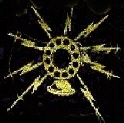
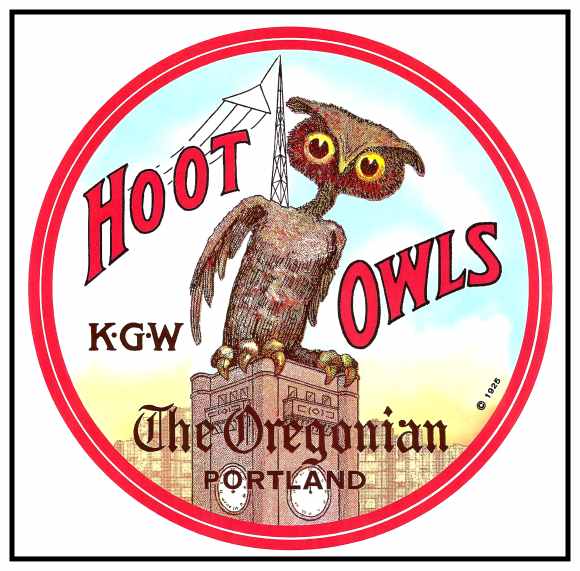
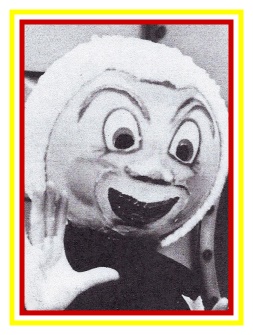
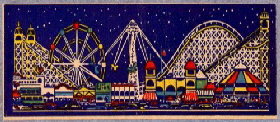

 |
 |
 |
 |
|||
 |
||||||
|
|
Members of the Tigard Beavers semi-professional baseball team take time out for a team photo circa 1914. Bill Schamoni is holding the bat. Also in the photo: Harry Kuehne, the two Welk brothers, Armour Ariss and the Rehberg brothers. The team was active from 1912 to 1915. |
|
The first known organized baseball team in the Northwest was recorded on May 28, 1866. On this day the Pioneer Baseball Club of East Portland was created. The teams were comprised of merchants, doctors, lawyers and farmers from rural Portland. The club was considered a "gentlemen's" group. As was the norm for the day, professionals were not allowed, and the "Club" was strictly for members to partake in for social purposes. The club had elected officials and a dues system: each member paid 50 cents to help buy baseballs for a dollar each and bats that cost $2.50 each. The Pioneers are on record as playing the Clackamas Club and winning handily 77-46. In the early years of baseball, the rules were different from those of today. Under hand pitching was allowed and batters called where they wanted a pitch over the plate. Scores of this nature were not uncommon at the time given the differences in the rules from today's game. The first games played by the Pioneers appear to have taken place on a vacant lot owned by Stimpson and Estes on Washington Street. Other games were played near Broadway and Stark downtown, but as time moved on, the team played in fields on the east side of Portland, just over the Willamette, hence the name "East" in the club’s name. The team played the best games on Clinton and McCoy field, the only field in town with a half-enclosed grandstand and bleachers. |
|
|
Early view of a baseball team at Estacada about 1920. |
|
On October 1, 1867, the Pioneer Base Ball Club invited representatives from other clubs to a meeting in February of 1868 to form a players association. Joe Buchtel was elected president of the five-team group that included the Pioneers, the Spartans of Portland, the Highland Base Ball Club, the Clackamas Club from Oregon City, and the Vancouver Occidentals, which included soldiers from the Ft. Vancouver garrison, with local civilians rounding out the Occidentals squad. |
|
|
Baseball team at Ockley Green School in North Portland about 1915 |
|
The players group operated as "The Oregon, Washington and Idaho Territories Association of Base Ball Players". They adopted the rules set down by the National Association of Ball Players that resided in New York and they were slightly modified for the Northwest group. Joe Buchtel was the person most acknowledged as popularizing baseball in Oregon in the latter part of the 19th century. In a short period of time, Buchtel went from elected director, to captain, to manager/player. He was a pitcher and an outfielder when the Pioneer Club won at least two State championships at the Oregon State Fair. Fleet of foot, Buchtel was said to have run 150 yards in fifteen seconds. In 1874 Buchtel reorganized the team and two years later won the Centennial Baseball Championship playing against the Clackamas Club, the Vancouver Occidentals and Willamette University. Joe Buchtel fulfilled his obligations as a player/manager for the Pioneers for 15 years. In 1884 he organized the next great team to come out of Portland, the Willamettes of East Portland. That team consisted of Joe Buchtel and his son Fred who played shortstop. Then came the outstanding Parrott family. This team was so successful that in 1890 they became the Portland Gladiators who helped organize the first fully professional organization, the Pacific Northwest League (PNL). This league consisted of Portland,Seattle, Tacoma, and Spokane. Making the transition from the amateur Willamettes to the professional Gladiators were Fred Buchtel, "Jiggs" Parrott, and Tom Parrott. The league soon was filled with players from leagues in Texas, the Midwest and New York. In 1891, the Gladiators played 94 games to win the league championship. During that season they also played teams from the California League, which included Sacramento, San Francisco and San Jose. The Monograms began in 1896 when 18-year old Cal Geil assembled some "neighborhood kids", mostly from Central and North Central High Schools, in a barn on East 12th and Pine Street with the idea of forming the best baseball team possible. They practiced on a field known only as "The Graders" in the area of NE Flanders to Hoyt and NE 9th to 11th. Games were played at a place called the Buckman field site. The Monograms played in Portland against teams with names like South Portland, Goose Hollow, Slabtown, the Phoenix team, the Vancouver Maroons, Oregon City and St. Helens. The team beat all the other teams in their league, setting up a playoff with the Washington State Champion, the Tacoma Four Spots, for the right to go to San Francisco and play the California champion in the Pacific Tournament which was sponsored by the San Francisco Examiner. The Monograms beat the Tacoma Four Spots 10-1 to advance. Even though the Monograms lost players to the flu, seasickness and injury, they still managed to tie the California League Champions 12-12 in the first game before losing a heartbreaker in the second game, 16-14. There were approximately 17,000 spectators at each game. Later that year, the Pacific Northwest League collapsed. In the Spring of 1901, construction began on a new baseball stadium on NW Vaughn Street between 24th and 25th Streets. F.I. Fuller’s Portland Railway Company owned the land, and he teamed up with rival streetcar company owner, C.F. Swigert of the City & Suburban Railway Company to build the park. The idea was simple…increase ridership on both streetcar lines and make money at the turnstiles. |
|
|
Aerial view of Recreation Park (Vaughn Street Stadium) which opened in 1901. |
|
The new baseball park opened on May 22, 1901 and the face of baseball in Portland would take on its greatest change. This day marked the beginning of 55 seasons of great baseball in Portland. It was on a rainy Wednesday afternoon when that first game was played at Recreation Park (Vaughn Street Park or simply the Baseball Park). It was the place where the Red Sox discovered Ted Williams. It was where the great Joe Tinker first played; it survived a massive 3-alarm fire and numerous floods. It was the heart and soul of the city. The Pacific Northwest League was revived in 1901 and when the National Association was organized, the league became a Class B member. While Fuller and Swigert owned the park, a group of prominent business owners, spearheaded by well-known baseball promoter named William H. Lucas, decided that the best way to bring favorable publicity to an ambitious young city was to bring in a baseball club. So began the Portland Baseball Club, as the ownership group assembled a team in 1901 called the Webfooters. Joe Tinker played Third base for the Webfooters in 1901 and would go on to the Baseball Hall of Fame. The Webfooters were an outstanding team and they went on to win the Pacific Northwest League championship in that 1901 season, but the remaining years of the team would not be anything near as good as the first. As the 1902 season approached, two more teams were added to the PNL; Butte and Helena, Montana made a total of six teams. Portland would finish fourth in the league. The PNL was folded into a new league. In 1903, the Pacific Coast League was formed and the Portland Browns had the worst record in the new league their first year. Other teams were fielded in Los Angeles, Oakland, Sacramento, San Francisco and Seattle during the league’s first season. With the coming of the Lewis & Clark Exposition and World’s Fair to Portland in 1905, Recreation Park (Vaughn Street Stadium) was used for the National Track & Field Games. The renamed Portland Giants played at Multnomah Field while Recreation Park was used as a track venue. The team was renamed again in 1906 and the Portland Beavers won their first Pacific Coast League title. The Beavers won PCL Championships again in 1910 and 1911. Vaughn Street Stadium was remodeled in 1912 and 12,000 fully enclosed bleachers seats were added in centerfield. Also, the first known Luxury Boxes were installed. The park stayed virtually unchanged until 1955 when the park known as Vaughn Street and Lucky Beavers Stadium was closed and torn down the following year. |
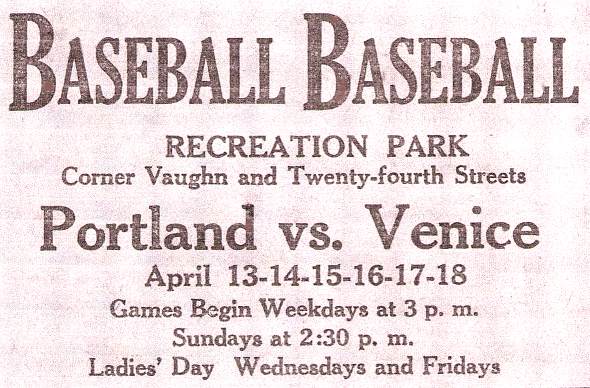 |
|||||
|
Ad from April 11, 1915 when Portland played the team from Venice, California |
|||||
|
The Beavers won PCL championships again in 1913 and 1914, but in 1918, the wartime travel restrictions forced them to cancel their season. After the war, the wins were few and far between. On March 25, 1922, the Beavers announced a strong batting lineup that included All-American Athlete Jim Thorpe playing in the outfield. However, a shoulder injury as well as a leg injury forced his release from Portland on June 1, 1922. Thorpe had been the highest paid ball player in the PCL at $1000 a month. Vaughn Street Stadium became the first to install coin drop turnstiles to speed entrance into the park. Finally, in 1932, the Portland Beavers won their sixth PCL crown. Four years later in 1936, the Beavers won their Lucky Seventh League Title. In 1945, the Beavers won their eighth league title and their last crown for 38 years. |
|||||
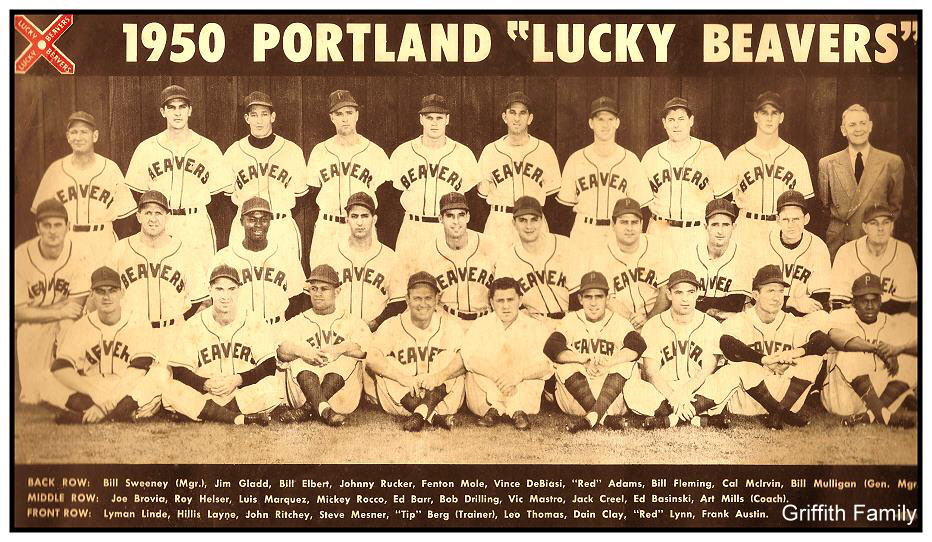 |
|
Team photo of the “Lucky Beavers” in 1950. Photo courtesy of the Griffith Family. |
|
In 1946, Vaughn Street Park also hosted the short-lived Portland Roses of the West Coast Negro Baseball Association. When the league was formed, Vice President of the league, Jesse Owens took ownership of the Portland Roses. The league was also made up of the Seattle Steelheads, the San Diego Tigers, the Los Angeles White Sox, the San Francisco Sea Lions and the Oakland Larks. Portland won their June 4th opener as 1,500 fans watched. Most of the teams soon found themselves in financial trouble and the Association folded in July 1946. Team members packed their bags and headed home. |
|
|
Sellwood team about 1918 |
|
The Beavers didn’t make any major headlines until they moved to Multnomah Stadium (later Civic Stadium and now PGE Park) in 1956. Multnomah Stadium was built in 1926 with a capacity of 28,000 and it was used almost exclusively for football games until 1956. That was the end of the old Vaughn Street Stadium, it simply died of old age. It was razed in 1957. The Beavers transplanted the grass from the old Vaughn Street Stadium to Civic Stadium. However, the grass vanished in 1969 when Civic Stadium was the first outdoor facility to install Astroturf. The Dodgers and Giants moved from New York to the West Coast in 1958, effectively transforming the PCL from baseball’s third major league into a AAA classification league. The Beavers become a Major League farm team for the first time joining the St. Louis Cardinals family as their AAA team in 1961. The Beavers became the AAA affiliate for the Kansas City Athletics in 1962. Then in 1964, the Beavers became the AAA team of the Cleveland Indians. The Beavers became the first AAA team in the history of the Milwaukee Brewers in 1970. In 1971, the Minnesota Twins become the Beavers’ new parent club. Then in 1972, the Beavers became the AAA team of the Cleveland Indians. In 1973, the Beavers moved to Spokane.Civic Stadium was remodeled again in the 1970’s when a new roof was added. The Press Boxes were moved from on top of the roof to under the roof. Single A Baseball came to Portland with the Mavericks Baseball Club which was owned by Bing Russell. You could count on seeing Bing’s teenage son, Kurt Russell, the actor, at nearly every game. The Mavericks generated quite a bit of excitement with their colorful promotions. Then Portland rejoined the PCL in 1978 as an expansion team and the AAA affiliate of the Cleveland Indians. In 1979, the Pittsburgh Pirates became the parent club of the Beavers. The Philadelphia Phillies become the Beavers’ parent club in 1983. In 1987, the Minnesota Twins became the Beavers’ parent club. Then in 1994, the Beavers moved to Salt Lake City. In 1995, the Bend Rockies of the Single A Northwest League moved to Portland. Triple A ball returned to Portland in 2001 when the Albuquerque Dukes moved to Portland to a remodeled Civic Stadium now known as PGE Park. The team revived the name Beavers and they became affiliated with the San Diego Padres. When the 20,000-seat Park was remodeled, Nexturf was installed on the playing surface. Luxury Boxes were added and they installed “Club” seating. The naming rights were sold to PGE and it was renamed PGE Park. After longtime mascot Round Tripper retired in 1994, he hand-picked his replacement, “Boomer” in 2001. Financial problems led to a two-year search to find new ownership, after the league assumed ownership, and Abe Alizadeh, 47, from Granite Bay, California invested in the Portland Beavers in 2005. The Sacramento River Cats owner stepped in and assumed operation of the club. Since then, Portland has seen game attendance climb. In 2007, Merritt Paulson, manager of Shortstop LLC and son of U.S. Treasury Secretary Henry Paulson, bought the Portland Beavers and the Portland Timbers, Portland’s popular soccer franchise from Portland Baseball Investment Group. In 2009, the Portland City Council voted to renovate the stadium and make it available for soccer and football. Without a stadium, Merritt Paulson sold the team. In 2011, the team was temporarily moved to Tuscon where they took on the name of the Padres. The team was sold again in 2014 and moved to west Texas where they became the El Paso Chihuahuas. |
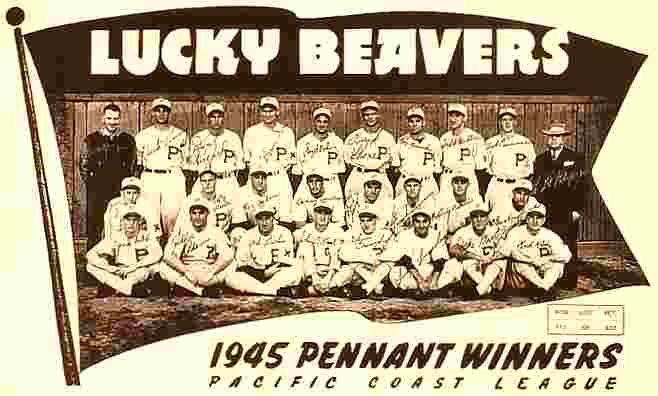 |
|||||||||
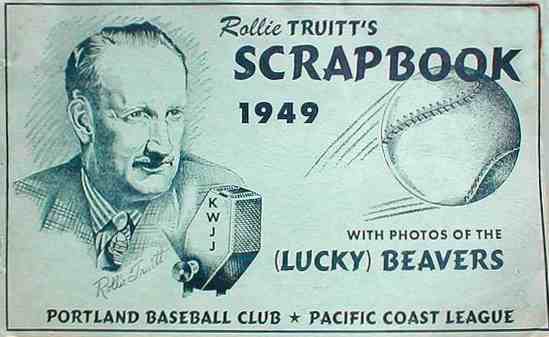 |
|||||||||
|
Last updated 11-07-16 |
|||||||||
|
copyright © 2017 PdxHistory.com |
| [Portland History] [Site Map] [Amusement Parks] [Historic Portland] [Street Scenes] [Department Stores] [Streetcars] [Railroads] [Mt Hood] [Oregon Coast] [Post Card History] [Portland Hotels] [Portland Neighborhoods] [Getaways] [Contact Us] |